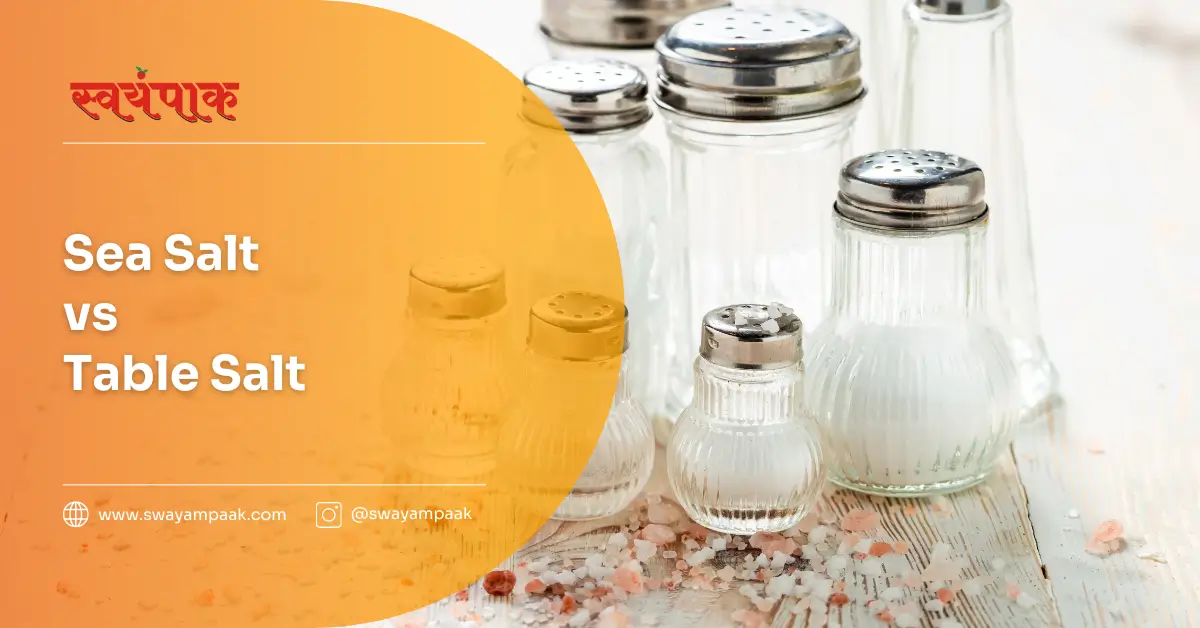Salt, a ubiquitous mineral, plays a crucial role in our culinary endeavours and overall health. From enhancing flavours to preserving foods, salt has been a kitchen staple for millennia. It’s essential for maintaining proper bodily functions, including fluid balance and nerve signal transmission.
However, the debate of sea salt vs table salt has gained traction in recent years, with each type boasting unique characteristics and potential benefits.
Sea Salt vs Table Salt | Let’s compare
What is Sea Salt?
Sea salt is derived from evaporated seawater, retaining trace minerals and elements from its source. The production process involves collecting seawater in shallow ponds and allowing natural evaporation, followed by harvesting and minimal processing.
Common varieties include fleur de sel, prized for its delicate flavour and harvested by hand from coastal waters in France, and Celtic salt, known for its grey colour and mineral-rich profile. These artisanal salts are often favoured by chefs for their distinct textures and nuanced tastes.
What is Table Salt?
Table salt, the most common household variety, is typically mined from underground salt deposits and heavily processed to remove impurities. The production involves dissolution in water, followed by evaporation and the addition of anti-caking agents to prevent clumping.
- Iodized table salt, introduced to combat iodine deficiency disorders, contains added iodine.
- Non-iodized versions are also available, often preferred for certain culinary applications where iodine might affect flavour or colour, such as pickling or curing meats.
Composition Comparison
Sea Salt vs Table Salt? How are they different in terms of composition? Whilst both sea salt and table salt are predominantly sodium chloride, their mineral content differs significantly. Sea salt retains trace minerals like magnesium, calcium, and potassium, reflecting its oceanic origin. These minerals can impart subtle flavours and colours.
Table salt, being more refined, consists almost entirely of sodium chloride. It often contains additives such as anti-caking agents (e.g., calcium silicate) to prevent clumping, and in the case of iodized salt, potassium iodide. The processing of table salt removes most naturally occurring trace minerals.
Taste and Texture Differences
Sea salt vs table salt in the flavour profile. Both these salts offer distinct flavour profiles and textures. Sea salt typically has a more complex, mineral-rich taste that can add depth to dishes. Its larger, irregular crystals provide a satisfying crunch and burst of flavour when used as a finishing salt.
Table salt, with its fine, uniform grains, has a sharper, more straightforward saltiness. It dissolves quickly, making it ideal for recipes where even salt distribution is crucial. The dissolution rates vary; table salt’s fine grains dissolve almost instantly, whilst sea salt’s larger crystals take longer, potentially affecting the overall mouthfeel of a dish.
Culinary Uses
Sea Salt vs Table Salt? What’s the usage in food and cuisines? Sea salt shines as a finishing salt, adding a flavourful crunch to dishes just before serving. It’s ideal for sprinkling over roasted vegetables, grilled meats, or homemade chocolates. Chefs often prefer sea salt for its texture in rustic bread or atop caramel desserts.
Table salt, with its fine texture and quick dissolution, is best suited for everyday cooking and baking. It’s particularly useful in recipes requiring precise measurements, such as in baked goods, where consistent salt distribution is crucial. For boiling pasta or seasoning soups, table salt’s ability to dissolve rapidly makes it the practical choice.
Nutritional Considerations
Here are some key points about the comparison:
- Sodium and Chloride: Both types of salt are primarily composed of sodium and chloride, with table salt having slightly higher amounts.
- Iodine: Table salt is usually iodized, containing significantly more iodine than sea salt. This is important for thyroid function.
- Trace minerals: Sea salt generally contains more trace minerals like potassium, calcium, and magnesium. However, the amounts are relatively small and may not significantly contribute to daily nutritional needs.
- Variability: The mineral content in sea salt can vary depending on its source and processing methods.
- Overall nutrition: Despite minor differences, both salts are nutritionally similar in terms of their impact on diet and health.
- Sodium content: Both are high in sodium, and excessive consumption of either type can lead to health issues like high blood pressure.
It’s worth noting that while sea salt contains more trace minerals, the quantities are generally not significant enough to make a substantial difference in most people’s diets. The choice between sea salt and table salt often comes down to personal preference in taste and texture rather than nutritional content.
| Nutrient | Sea Salt (per 100g) | Table Salt (per 100g) |
|---|---|---|
| Sodium | 38,000 mg | 39,000 mg |
| Chloride | 58,500 mg | 60,000 mg |
| Iodine | 0.5-5 mcg (variable) | 1,800-2,200 mcg |
| Potassium | 50-100 mg | 0-8 mg |
| Calcium | 30-80 mg | 0-20 mg |
| Magnesium | 30-50 mg | 0-2 mg |
| Iron | 0.3-0.5 mg | 0-0.1 mg |
| Zinc | 0.1-0.5 mg | 0-0.1 mg |
| Manganese | 0.1-0.5 mg | 0-0.1 mg |
Environmental Impact
- Sea salt has a relatively low environmental impact, as its production involves solar evaporation of seawater, requiring minimal energy. However, there are concerns about pollution and microplastics in the oceans, which may affect the purity of sea salt.
- In contrast, table salt is usually extracted through underground mining, which can be energy-intensive and result in significant habitat disruption, including landscape alteration and potential harm to local ecosystems.
Production Methods
- Sea salt is produced by evaporating seawater in large shallow ponds, leaving behind salt crystals. This process relies on natural factors such as sunlight and wind, with minimal processing involved.
- Table salt, on the other hand, is typically mined from underground salt deposits formed by ancient oceans. After mining, it undergoes refinement to remove impurities and is often fortified with iodine to prevent iodine deficiency. Anti-caking agents are also added to prevent clumping.
Sustainability Concerns
While sea salt harvesting has a smaller direct environmental footprint, it raises sustainability concerns regarding ocean health. Pollution, including microplastics and other contaminants, can affect the quality and safety of the salt.
Conversely, large-scale table salt mining operations can cause soil erosion, deforestation, and water contamination. The energy used in refining table salt also contributes to its environmental impact. Both types of salt face challenges in achieving sustainable production, but their issues differ in nature.
Cost Comparison
Sea salt is typically more expensive than table salt due to its labour-intensive harvesting process and its association with gourmet cooking. It is often marketed as a premium product, particularly when sold in coarse crystals or flakes.
Table salt, being mass-produced through mining and refining, is much cheaper and more widely available. Its affordability and long shelf life make it a staple in households around the world.
- Table salt: ₹15-30 per kg for common brands.
- Sea salt: ₹50-150 per kg, with premium brands potentially costing more.
Table salt is usually less expensive than sea salt in India, as it is more heavily processed and produced on a larger scale. Sea salt is often priced higher due to its perceived health benefits, less processing, and sometimes its origin from specific coastal areas.
The price difference can vary, but sea salt might cost anywhere from 1.5 to 5 times more than regular table salt, depending on the brand and quality.
Conclusion
Despite these differences, it’s important to remember that both types of salt are primarily sodium chloride and have similar effects on our health when it comes to sodium intake. The choice between sea salt and table salt often comes down to personal preference, cooking application, and dietary considerations.
For most people, the nutritional differences are negligible, and both can be part of a healthy diet when used in moderation. Whether you’re sprinkling flaky sea salt on a gourmet dish or using table salt in your everyday cooking, the key is to be mindful of your overall sodium consumption for optimal health.
Ultimately, the salt debate isn’t about which one is “better,” but rather about understanding their unique characteristics and using them appropriately in your culinary adventures. So go ahead, experiment with both, and find the perfect balance for your palate and your plate!


